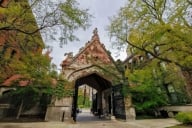You have /5 articles left.
Sign up for a free account or log in.
One way for presidents to deal with the problems of college sports is to run and hide. That’s a message that comes from Joe Nocera’s recent New York Times column about the former chancellor of the University of North Carolina at Chapel Hill who is about to become provost at Washington University in St. Louis.
A succession of academic scandals involving coaches and athletes took place on his watch. If the NYT column is accurate, retreat rather than reform seems to be a solution of sorts, as former UNC Chancellor Holden Thorp “will soon move to Washington University in St. Louis, a first-rate academic institution that no one will ever mistake for the University of North Carolina athletically. It is in Division III, meaning, among other things, it doesn’t offer athletic scholarships.”
Provost-to-be Thorp may be in for some surprises about his new university home. First, Washington University does share some things with UNC Chapel Hill. Both were NCAA men’s basketball champions in 2009. And, even though UNC Chapel Hill is considered a men’s basketball dynasty, only Washington University can claim back-to-back championships, as its men’s team also won the crown in 2008.
Another and less-pleasant surprise for the new provost -- if Nocera's column accurately represents his views -- may be that NCAA Division III is hardly a “problem free zone” or “safe place” for college sports. Academic leaders, whether at UNC Chapel Hill or Washington University in St. Louis, share a continual need to make sure that the varsity sports program is in tune with the respective institution’s mission. Just the fact that a college sports program in Division III and does not offer athletic scholarships does not exempt it from serious problems in maintaining harmony among academics and athletics.
Academically selective colleges that do not grant athletic scholarships have their own headaches. For example, at an Amherst or a Williams in Division III – and, at an Ivy League institution in NCAA Division I-AA – the high-stakes tension comes in deciding which among many academically strong applicants are offered admission. Varsity sports are crucial, since somewhere between 25 percent and 33 percent of an entering freshman class are recruited athletes. Before one characterizes NCAA Division III college sports as a paradise of amateurism, look again.
Presidents and athletic directors at large public flagship universities may bemoan their plight in having to deal with zealous State U. boosters. But that is no less difficult than the president of a selective liberal arts college who has to deal with irate parents from the State Department who are alumni and want to know why their academically talented children who do not play a varsity sport lost out on admissions to a recruited athlete.
Academically selective colleges in Division III and Division I-AA take sports seriously. Williams College has won the coveted national Directors Cup many times – mirroring the record of Stanford in Division I. Sportswriters often foster the impression that Division III is comparable to intramural sports. It is not. The training, preparation, competition and rivalries of Division I have diffused to Division III. What’s surprising about Nocera’s depiction of the chancellor-now-provost (assuming it captures Thorp’s views accurately) is his unfamiliarity with these developments.
Presidents often complain about how much of their official time is devoted to dealing with college sports programs. One partial solution is a structural change – rethink the conventional wisdom and practice that an athletics director must or should report directly to the president – a privilege usually not granted to academic deans.
Rely on the expertise of, e.g., vice presidents to screen and filter – and be responsible for – some athletics questions. This reform could still retain the president as having time for attention to deliberations and ultimate decision-making on major intercollegiate sports issues while providing a buffer from distractions of more routine athletic matters.
Does higher education lack leaders who could bring sense and sensibility to college sports? I don’t think so. My incomplete nominations start with Jeff Orleans, former executive director of the Ivy Group, and Amy Perko of the Knight Commission. Among incumbent college presidents I would include John Roush, president of Centre College, who played varsity football at Ohio University and was an academic all-American. If I were asked to identify an athletics director who can combine educational values with business experience I would nominate Bob Scalise, Harvard’s athletics director since 2001. A decade ago I heard AD Scalise note that his primary concern was maintaining trust and legitimacy with the dean of Harvard College.
College leaders – whether presidents, provosts, deans or boards – have had access for over three decades to good resources and people to help them deal with college sports.
The Knight Commission tooled up in the late 1980s. I still consider then-New York University President L. Jay Oliva’s 1989 special report to the Association of Governing Boards, "What Trustees Should Know About Intercollegiate Athletics," to be indispensable. The former college president Robert Atwell devoted years at the American Council on Education working to inform academic leaders about the significance of adding college sports to the major responsibilities.
And, more recently, James Antony, Sara Lopez, and Jennifer Hoffman at the University of Washington’s Center for Leadership on Athletics provide the kinds of programs and expertise that would be helpful to present and future college presidents.
Many of the studies on athletics have tended to focus on big-time college sports programs. But look again: William G. Bowen, former president of Princeton, transformed the Mellon Foundation research resources into influential, data driven works that sounded the alert, if not the alarm, about cumulative problems of college sports that did not offer athletic scholarships. Perhaps it’s time for a new generation of presidents and provosts to discover (or reread) Bowen and Sarah Levin’s superb 2001 book, Reclaiming the Game: College Sports and Educational Values.
And it’s their subtitle that is the key: presidents, whether at Division I or Division III, cannot abdicate their responsibilities to face, not ignore, sports challenges because ultimately college sports is about educational values. Both new and incumbent presidents and provosts need to cooperate with their conferences to clarify the place of intercollegiate athletics in their conference and campus educational mission statements.








